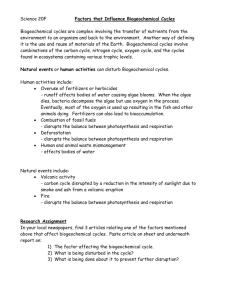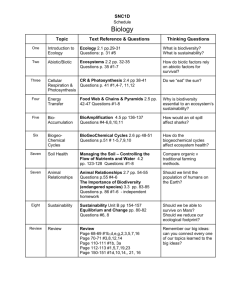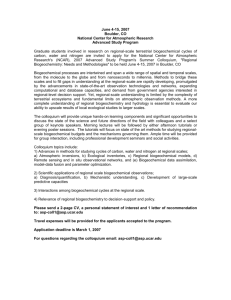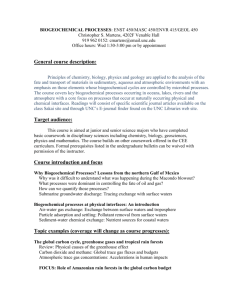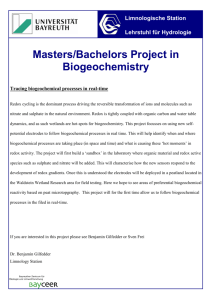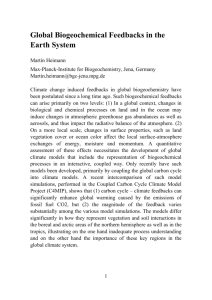3.2. Biogeochemical Cycles
advertisement
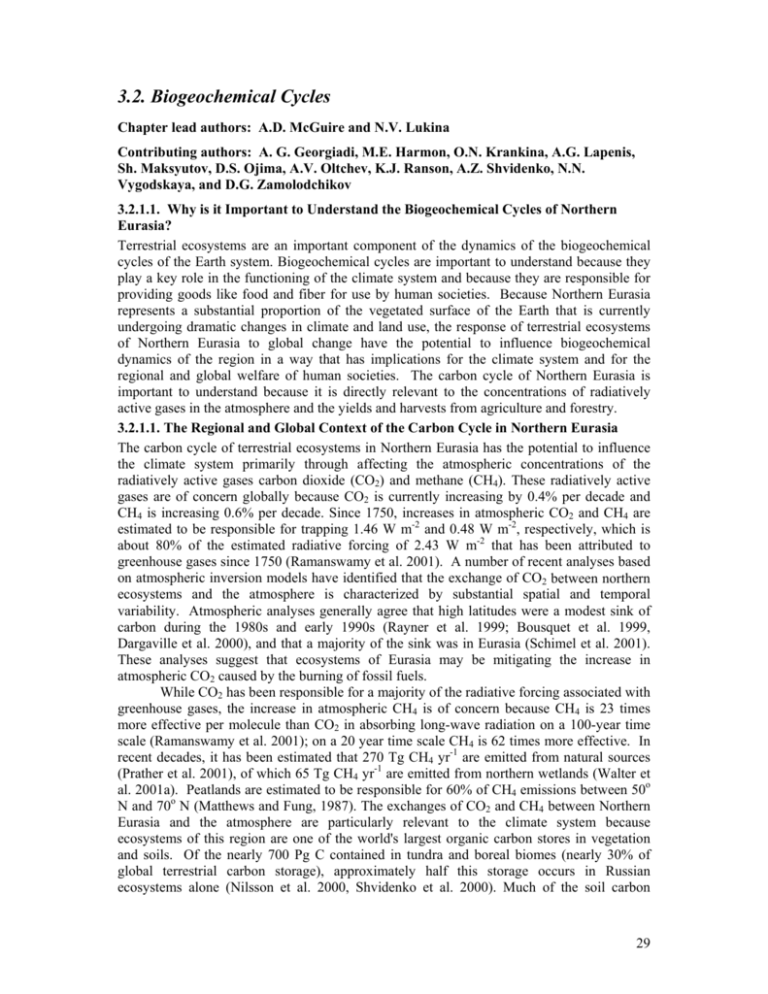
3.2. Biogeochemical Cycles Chapter lead authors: A.D. McGuire and N.V. Lukina Contributing authors: A. G. Georgiadi, M.E. Harmon, O.N. Krankina, A.G. Lapenis, Sh. Maksyutov, D.S. Ojima, A.V. Oltchev, K.J. Ranson, A.Z. Shvidenko, N.N. Vygodskaya, and D.G. Zamolodchikov 3.2.1.1. Why is it Important to Understand the Biogeochemical Cycles of Northern Eurasia? Terrestrial ecosystems are an important component of the dynamics of the biogeochemical cycles of the Earth system. Biogeochemical cycles are important to understand because they play a key role in the functioning of the climate system and because they are responsible for providing goods like food and fiber for use by human societies. Because Northern Eurasia represents a substantial proportion of the vegetated surface of the Earth that is currently undergoing dramatic changes in climate and land use, the response of terrestrial ecosystems of Northern Eurasia to global change have the potential to influence biogeochemical dynamics of the region in a way that has implications for the climate system and for the regional and global welfare of human societies. The carbon cycle of Northern Eurasia is important to understand because it is directly relevant to the concentrations of radiatively active gases in the atmosphere and the yields and harvests from agriculture and forestry. 3.2.1.1. The Regional and Global Context of the Carbon Cycle in Northern Eurasia The carbon cycle of terrestrial ecosystems in Northern Eurasia has the potential to influence the climate system primarily through affecting the atmospheric concentrations of the radiatively active gases carbon dioxide (CO2) and methane (CH4). These radiatively active gases are of concern globally because CO2 is currently increasing by 0.4% per decade and CH4 is increasing 0.6% per decade. Since 1750, increases in atmospheric CO2 and CH4 are estimated to be responsible for trapping 1.46 W m-2 and 0.48 W m-2, respectively, which is about 80% of the estimated radiative forcing of 2.43 W m-2 that has been attributed to greenhouse gases since 1750 (Ramanswamy et al. 2001). A number of recent analyses based on atmospheric inversion models have identified that the exchange of CO2 between northern ecosystems and the atmosphere is characterized by substantial spatial and temporal variability. Atmospheric analyses generally agree that high latitudes were a modest sink of carbon during the 1980s and early 1990s (Rayner et al. 1999; Bousquet et al. 1999, Dargaville et al. 2000), and that a majority of the sink was in Eurasia (Schimel et al. 2001). These analyses suggest that ecosystems of Eurasia may be mitigating the increase in atmospheric CO2 caused by the burning of fossil fuels. While CO2 has been responsible for a majority of the radiative forcing associated with greenhouse gases, the increase in atmospheric CH4 is of concern because CH4 is 23 times more effective per molecule than CO2 in absorbing long-wave radiation on a 100-year time scale (Ramanswamy et al. 2001); on a 20 year time scale CH4 is 62 times more effective. In recent decades, it has been estimated that 270 Tg CH4 yr-1 are emitted from natural sources (Prather et al. 2001), of which 65 Tg CH4 yr-1 are emitted from northern wetlands (Walter et al. 2001a). Peatlands are estimated to be responsible for 60% of CH4 emissions between 50o N and 70o N (Matthews and Fung, 1987). The exchanges of CO2 and CH4 between Northern Eurasia and the atmosphere are particularly relevant to the climate system because ecosystems of this region are one of the world's largest organic carbon stores in vegetation and soils. Of the nearly 700 Pg C contained in tundra and boreal biomes (nearly 30% of global terrestrial carbon storage), approximately half this storage occurs in Russian ecosystems alone (Nilsson et al. 2000, Shvidenko et al. 2000). Much of the soil carbon 29 storage in the region is stored in peatlands, which occupy about 20% of Russia’s land cover and contain about 120 Pg C (Vompersky et al. 1994, Alexeyev and Birdsey 1998). Riverine export of terrestrial ecosystem carbon to coastal and ocean ecosystems, which is estimated to be about 60 Tg C yr-1 from Russian rivers (Nilsson et al. 2003), is another important link in the global carbon cycle that is controlled by terrestrial ecosystem processes and hydrologic linkages with freshwater aquatic ecosystems. The carbon cycle of terrestrial ecosystems in Northern Eurasia has come under direct human management through agriculture (including grazing of domestic livestock) and forestry activities. Human use of plant biomass in these activities uses approximately 15% of the net primary production of Northern Eurasia (Nilsson et al. 2003). The flux of harvestable products that contain carbon not only provide food, but also compete in the market place with fossil fuels, and with other materials for construction (such as cement) and other purposes (such as plastics), and have implications for the global carbon cycle (Kauppi et al. 2001). 3.2.1.2. Interactions of Other Element Cycles with the Carbon Cycle in Northern Eurasia While the direct effects of biogeochemical cycles on the climate system and human societies can generally be elucidated in terms of the carbon cycle, cycles of other elements interact with the dynamics of the carbon cycle and are also important to understand. Nitrogen is an important element in the chemical structure of enzymatic proteins, which are responsible for catalyzing biochemical reactions in organisms. Interactions between carbon and nitrogen dynamics are particularly important to understand because the production of plant biomass in northern ecosystems is generally limited by the availability of nitrogen to plants (Vitousek and Howarth, 1991). Human activity has modified the global nitrogen cycle in several ways (Vitousek et al. 1997) that may be influencing plant growth in Northern Eurasia. In particular, fossil fuel burning has released nitrogen- and sulfur-based trace gases into the atmosphere, which are being deposited into terrestrial ecosystems. Increased N availability associated with N deposition may cause an increased rate of soil organic matter accumulation due to an increased biomass and litter production combined with reduced decomposition of organic matter (Berg and Matzner, 1997). However, N fertilization in the N deficient northern forests delays the hardening-off process, resulting in increased winter damage, and thus negating some of the growth enhancement (Makipaa et al. 1999). Increasing CO2 levels may also be affecting the interactions between carbon and nitrogen as N concentration in hardwood leaf litter is reduced when plants are raised in an elevated CO2 atmosphere (Cotrufo et al. 1998). Interactions of the carbon cycle with other elements are also important to understand. Atmospheric pollution can have impacts on plant productivity (Roose et al., 1982; Scholz et al., 1989; Tingey and Andersen, 1991; Gravenhorst et al., 2000), for example, through the effects of elevated levels of tropospheric ozone and sulfur dioxides in decreasing photosynthesis. Also, the deposition of heavy metals has had dramatic impacts on vegetation downwind from smelters (Johansson et al. 2001). 3.2.1.3. Responses of Biogeochemical Cycles in Northern Eurasia to Global Change The biogeochemical cycles of terrestrial ecosystems in Northern Eurasia may respond to global change in ways that tend to enhance warming (positive feedbacks) and through effects that tend to mitigate warming (negative feedbacks) (Smith and Shugart, 1993; McGuire and Hobbie, 1997; McGuire et al. 2000a; Chapin et al. 2000; Clein et al. 2002). The net effect will depend on the balance between the two and positive feedbacks to warming are of imminent concern. To predict the effects of climate and land cover change on the future dynamics of CO2 and CH4 exchange in northern Eurasia, it is important to understand the processes involved and their spatial and temporal dynamics. Predicting the long-term influence of elevated CO2 concentrations on the carbon stocks of forest ecosystems remains a 30 research challenge (Bolin et al. 2000; Prentice et al. 2001, Arneth et al. 2002). Ecosystems that initially absorb C in response to higher atmospheric CO2 will become ‘saturated’ or even later release CO2 if increasing temperatures lead to enhanced decomposition and respiration (Cao and Woodward, 1998; Scholes et al. 1999). Fires and other disturbances could increase in frequency and intensity if temperatures increase and precipitation patterns change. The net impact of these, and other global changes, is an area of active research (e.g., Woodwell et al. 1998). Changes in land use also affect the biogeochemical cycles in forest, grassland, and other ecosystems. The dynamics of land use, which are driven by different socio-economic factors in China, Mongolia, Russia and the other former Soviet Union Republics, have implications for biogeochemistry (e.g., the stability of permafrost has been affected in areas disturbed by resource extraction activities; Ivanov 2003). However, how these changes have affected biogeochemical cycles in not well documented and is not well understood. The future trends of land use are uncertain and will likely affect the future storage of carbon and the dynamics of other biogeochemical cycles in the region. 3.2.2. Science Questions Because Northern Eurasia plays a major role in the global carbon cycle, understanding this role and projecting the future dynamics of biogeochemical cycles in Northern Eurasia is critically important to understanding and projecting the future dynamics of the climate system. Furthermore, an improved understanding of the biogeochemical cycles in Northern Eurasia is important for developing comprehensive, policy-relevant knowledge of the global carbon cycle. A major objective of the UN Framework Convention on Climate Change (FCCC) is decreasing concentration of radiatively active gases in the atmosphere, which requires a full accounting of the dynamics of these gases (Steffen et al. 1998). Thus, the NEESPI science questions that we define for biogeochemical cycles are designed to be parallel with the major themes of the Global Carbon Project (2003), which has developed an international framework for understanding the dynamics of the global carbon cycle in a manner that develops knowledge relevant to predicting responses of the carbon cycle and for supporting policy decisions to manage the carbon cycle. Thus, the NEESPI program addresses the following broad themes with special focus on issues relevant to the Northern Eurasia region: • Patterns and Variability: What are the current geographical and temporal distributions of the major stores and fluxes of carbon and other elements in Northern Eurasia that are important to the functioning of the climate system and human societies? • Processes and Interactions: What are the major drivers and feedback mechanisms – both anthropogenic and non-anthropogenic – that control the dynamics of the carbon and other important biogeochemical cycles at local, regional, and continental scales in Northern Eurasia? • Responses of Biogeochemical Cycles: What are the likely future dynamics of biogeochemical cycles in Northern Eurasia that are important to the functioning of the climate system and human societies? • Management of Biogeochemical Cycles: What points of intervention and windows of opportunity exist for human societies to manage biogeochemical cycles in Northern Eurasia in a way that mitigates the effects of global change on the climate system and human societies? 3.2.3. Patterns and Variability An understanding of the patterns and variability in biogeochemical cycles is important for developing hypotheses about processes and interactions responsible for patterns and variability, for improving prognostic capabilities to predictively model the responses of 31 biogeochemical cycles to global change, and for providing information relevant policies and management of biogeochemical cycles. Atmospheric, terrestrial, and coastal/oceanic observations are important to developing a better understanding of the temporal dynamics and spatial variability of the carbon and other biogeochemical cycles in Northern Eurasia. Because it is not possible to measure everything, everywhere, and all of the time, patterns and variability must be diagnosed with approaches that involve the use of both observations and models. The approaches to diagnosis in this science plan are similar to those of the North America Carbon Program (NACP). Major elements of the diagnostic analyses of carbon and other biogeochemical cycles of Northern Eurasia should include: • A hierarchical approach for large-scale, distributed terrestrial measurements, including improved estimates of patterns of disturbance that are resolved in time and space. • Systematic compilation and analysis of new and existing remotely sensed imagery for use in models of carbon exchange; • Comprehensive description of properties of individual landscapes and ecosystems into spatially explicit data layers; • An atmospheric observing system consisting of ground stations, aircraft and measurements from towers; • Improved fossil fuel emissions inventories with high resolution in time and space, and methods for evaluating these inventories using atmospheric measurements; • Improved estimates of nitrogen, sulfur, and heavy metal deposition that are resolved in time and space. • Hydrologic transfers of carbon over land, and sequestration in sediments; • Ocean measurements and modeling, both in the coastal zone and the open ocean. • Synthesis and integration activities organized into three interlocking strategies: Spatiallydistributed modeling of carbon cycle processes using process-based models driven by many kinds of observations; top-down synthesis using inversion of variations in atmospheric trace gas composition and tracer transport models; and model-data fusion and data assimilation to produce optimal estimates of spatial and temporal variations that are consistent with observations and process understanding; • Interdisciplinary intensive field campaigns designed to evaluate major components of the model-data fusion framework in limited domains in space and time for which all major fluxes can be measured by multiple techniques. 3.2.4. Processes and Interactions It is important to develop an understanding of the processes and interactions responsible for patterns and variability of biogeochemical cycles because this understanding is necessary for being able to diagnose, predict and manage the responses of biogeochemistry to global change. The processes responsible for the responses of biogeochemical dynamics in monitoring studies and manipulation experiments need to be elucidated at a range of temporal and spatial scales. Major elements of the process-oriented research activities on biogeochemical cycles in NEESPI should include: • Responses of terrestrial biogeochemistry to changes in atmospheric CO2, climate, nitrogen/sulfur deposition, atmospheric pollution (tropospheric O3 and sulfur oxides), and heavy metal contamination; • Responses of terrestrial biogeochemistry to changes in disturbance regimes, forest management, and land use; • Responses of terrestrial biogeochemistry to agricultural and range management; • The impacts of lateral flows of carbon in surface water from land to fresh water and to coastal ocean environments 3.2.5. Responses of Biogeochemical Cycles 32 An important goal of research on biogeochemical cycles is to improve prognostic models of the carbon cycle that includes interactions with other biogeochemical cycles. This is important for being able to predict the responses of these cycles, which is information necessary for informing policy. Research to improve prognostic models require the synthesis of information from observations and process studies, retrospective analyses to evaluate model performance, and comparisons with diagnostic models. Predictive models of biogeochemical are also important tools that can be used in scenario research to examine potential sensitivity of biogeochemical cycles to projected changes. Finally, research leading to improved prognostic biogeochemical models will allow the develop of coupled climatesocial-ecological models that can be used for purposes of integrated assessment of responses of the NEESPI region to global change. Major elements of the predictive modeling activities on biogeochemical cycles supported under NEESPI should include: • Transfer of synthesized information from process studies into prognostic models of the carbon-cycle models that include interactions with other biogeochemical cycles; • Retrospective analyses to evaluate the spatial and temporal dynamics of disturbance regimes simulated by prognostic models; • Evaluation of temporal and spatial variability simulated by prognostic models with estimates of variability based on continued monitoring using legacy observational networks and diagnostic model-data fusion systems; • Development of scenarios of future changes in driving variables of prognostic models; • Application and comparison of prognostic models to evaluate the sensitivity of carbon storage and the dynamics of other biogeochemical cycles into the future; • Consideration of ecosystems as ecological-social systems and development of corresponding coupled models; and • Incorporation of prognostic biogeochemical models into coupled models of the climate system. 3.2.6. Management of Biogeochemical Cycles Research on diagnosis, understanding, and prediction should translate into an ability to better inform policy decisions that involve the management of carbon and other biogeochemical cycles in Northern Eurasia. Coupled models that integrate physical, ecological, and social processes are important tools that can examine vulnerabilities to future change, and identify options for mitigating vulnerabilities. Major elements of the research related to management of biogeochemical cycles to be provided by NEESPI should include analyses of: • Economics and energy policy options for management of the carbon and other biogeochemical cycles given improved diagnosis, understanding, and prediction; • Analyses of the permanence of sinks and vulnerability of carbon pools and methane exchange; • Scenario development for incorporation into coupled models of the climate system so that future climate can be simulated; • Assessment of sequestration options given the best scientific evaluation of present and future behavior of biogeochemical cycles. 33
